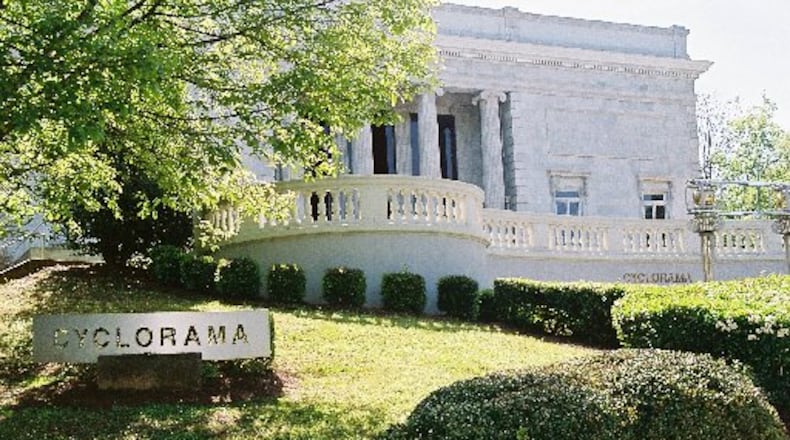Atlanta’s Cyclorama, a giant painting in the round, opens Feb. 22, 2019 in the brand-new Lloyd and Mary Ann Whitaker Cyclorama Building, a 25,000-square-foot rotunda on the Atlanta History Center campus.
The cycloramic painting, completed in 1886, was housed for years near Zoo Atlanta in Grant Park.
Here is a timeline and history of the painting:
"The Battle of Atlanta" was created during the heyday of the cyclorama, when mammoth panoramic paintings were displayed in cylindrical wooden buildings around the country, and thousands of customers would line up to immerse themselves in these virtual worlds.
The paintings were generally 50 feet high and 375 feet in circumference. They surrounded the viewer and tricked the eye into seeing three dimensions. As entertainment ventures, they were profitable, though the emerging technology of motion pictures would hasten the end of the cycloramic painting.
A team of 17 German and Austrian immigrants led by Friedrich Wilhelm Heine painted “The Battle of Atlanta” in 1886 in Milwaukee. Members of the group visited Atlanta to photograph and sketch the landscape. They also interviewed Civil War veterans in Wisconsin.
The Atlanta Cyclorama was intended to celebrate the Union victory during the July 22, 1864, battle east of downtown Atlanta, a triumph that became the turning point in the war.
1886: The “Atlanta” cycloramic painting was completed by American Panorama Co., Milwaukee.
1887: First displayed in Detroit.
1890: Paul Atkinson of Madison buys the “Atlanta” for $2,500 and displays it in Chattanooga, Tennessee.
1892: Atkinson moves the “Atlanta” to a wooden building on Edgewood Avenue in downtown Atlanta.
1893: Atkinson sells the painting to a Florida businessman.
January 1893: A freak snowstorm caves in the Edgewood structure’s roof.
August 1893: The “Atlanta” is sold at auction for $1,100 to collect rent due to the Edgewood property’s landlord. Later that year, the painting moves to a wooden structure in Grant Park.
1898: Atlanta businessman George V. Gress gives the Cyclorama to the city.
1921: A new "fireproof" Cyclorama building opens in Grant Park, with a rotunda that is several feet too short in circumference for the complete painting. Historian Wilbur Kurtz wrote that the city utilized a "Procrustean" solution: lopping off several feet of the painting to make it fit.
1979-1982: The Cyclorama undergoes a $15 million renovation, which includes building a rotating gallery for the audience.
2008: Restoration of the Gettysburg Cyclorama prompts calls for new restoration and possible relocation of Atlanta painting.
2011-2012: Advisory group’s report lays out options for the Cyclorama.
2014: 150th anniversary of the Battle of Atlanta.
July 23, 2014: Plans are announced to move the Cyclorama from its Grant Park home to the Atlanta History Center, where a structure will be built for it.
June 30, 2015: The last day the Cyclorama is open at its Grant Park location.
December 2015: The locomotive Texas is removed from the Cyclorama building and taken to North Carolina for restoration. Construction of new Cyclorama building begins at the History Center.
February 2017: The painting is wound onto two 45-foot scrolls and trucked across town to the History Center.
May 2017: The Texas is moved to the History Center. The locomotive went on display in November 2018.
Feb. 22, 2019: The planned opening of "The Battle of Atlanta" exhibit at the Atlanta History Center.
--Compiled by Bo Emerson, bemerson@ajc.com
Keep Reading
The Latest
Featured




